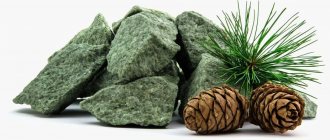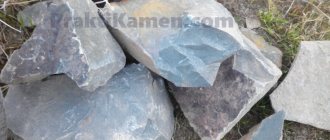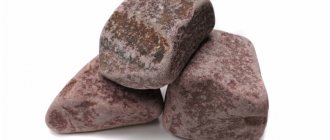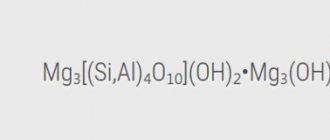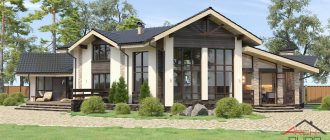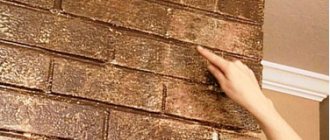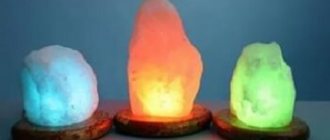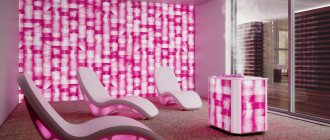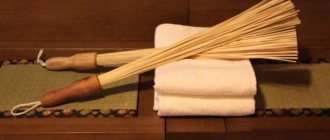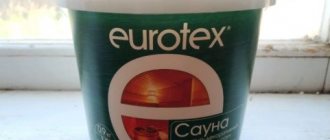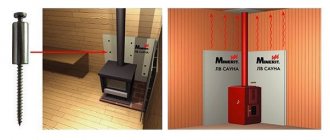Porphyrite. Photo Camelot178
So, you are about to fill the heater, go to the store and see boxes labeled “porphyrite”, “quartzite”, “soapstone”, “gabbro-diabase”, “jadeite”, etc. If you are not a geologist, then many questions arise about properties of different bath stones, about the best one, features of choice, etc. We have written this article to help you. It will be dedicated to bath porphyrite, but we will compare it with many other stones.
What is porphyry
The porphyry mineral is an opaque rock of volcanic origin.
Quartz-free porphyry, brown color associated with iron
The color range is rich: red, yellow, green, brown, gray, ink colors in many shades or combinations thereof.
Quartz-free porphyry with biotite and pyroxene
It is similar to granite (in some varieties it looks indistinguishable). However, porphyry is easy to distinguish: it is stronger, lighter, and never crumbles.
Porphyry, close in composition to rhyolite, was mined in the vicinity of Krakow
For thousands of years, porphyry has been used as a building, decorative and healing material:
- Altai stone was used in the construction of St. Petersburg. Palaces, park sculptures, and paved paths were built from it. The interior decoration consisted of large bowls and floor vases made by Russian craftsmen. They were admired by visitors to world exhibitions in Paris and other European capitals. Today they are the pride of the Hermitage collections.
- Presentable specimens are turned into cabochons for jewelry, boxes, candlesticks, and photo frames.
- Porphyry slabs become countertops, mantels, and stairs.
- The main highways of Europe are covered with Italian porphyry. The stone is rough and does not slip even when wet. This property is especially suitable for downhill roads.
A quartz-free type of stone – porphyrite – is a popular material for baths, steam rooms, and saunas.
Porphyry bowl
Varieties
Depending on the chemical composition of serpentinite and the presence of certain impurities in it, there are several types of stones that differ in color, texture and pattern. Here are some of them:
- Verdantite is dark green with silver veins.
- Bowenite is pale green, slightly translucent.
- Williamsite is green-blue, slightly shimmering like a cat's eye.
- Ophicalcite (serpentinite marble) - has characteristic spots and streaks reminiscent of a marble surface.
- Noble serpentine - yellow-green or white-green with black specks. May show through on thin chips.
- Ricolite is yellow-green with a striped pattern.
- Retinolite - honey yellow. Has an attractive resinous luster.
The best stones for a bath
Bath stones can be selected according to two criteria: performance and quality characteristics, as well as healing properties, in accordance with the needs of the body and health status.
The breed is environmentally friendly, high density and durable. The color range is represented by all shades of gray, despite the rather boring appearance, they are often used for lining stoves in bathhouses, since soapstone has exceptional heat capacity. The heating time is minimal, after which the stone releases heat evenly over a long period of time.
The healing properties of soapstone include strengthening the immune system, activating metabolic processes, eliminating colds and inflammatory processes. Due to the surprisingly gentle effect of steam on the body, it is often compared to sunlight.
The only drawback of the stone may be the presence of dust in the air, but before the first use it is enough to wash it, calcinate it, and fully enjoy your bathing holiday.
This is an amazingly beautiful exquisite stone of pleasant emerald shades. The mineral has rightfully gained popularity among bath lovers. It has high strength, which is several times higher than that of other stones, while jadeite is able to perfectly accumulate heat and release it in the form of powerful steam.
The steam rooms of the most famous Sandunovsky baths are decorated with this particular mineral, because its complex chemical composition, which contains more than sixty elements, has a beneficial effect on all human systems and organs. Steam makes breathing easier, eliminating the symptoms of many respiratory tract pathologies, and normalizes blood pressure. Bath procedures are indicated for people with diseases of the endocrine, circulatory, cardiac, nervous and urinary systems.
The disadvantages include the rather high price of jadeite.
The second name of the stone is Tsarsky and this is due to two distinctive features of the mineral: exceptional durability and rarity. The only place where quartzite is mined is Karelia, on the coast of Lake Onega. The aesthetic value of the mineral is in its amazing, rich purple hue. In any room, crimson quartzite becomes an original, bright accent.
In addition, the mineral has all the properties necessary for use in a bath: high density, hardness, wear resistance, and low water absorption. Perhaps, of all the bath stones, it is quartzite that can withstand sudden temperature changes and the most intensive use. That is why you can safely pour ice water onto a hot mineral.
From a medical point of view, the stone also fully justifies its “royal” name, because its healing properties help normalize blood pressure and eliminate rheumatic pain in the muscles.
The disadvantage of the stone is its rarity and high cost. It should also be noted that it is not recommended to use specimens with cracks: under the influence of heat, the stone continues to crumble.
This is an absolutely eco-friendly stone with a translucent structure. A unique property of quartz is the presence of oxygen in its composition. After intense heating and rapid cooling, ozone molecules are released, energizing and purifying the air. The Slavs have long called quartz “bath stone” and used it specifically to create thick steam.
Thanks to oxygen, quartz is able to effectively cleanse the respiratory tract, have a powerful rejuvenating effect, and also restore the upper layer of the epidermis. The healing effect of the mineral is felt for several days after the bath procedures.
Experts are surprised by the fact that porphyrite is not popular among bath lovers. Meanwhile, the stone has a high heat capacity, is able to accumulate heat and release it for a long time to the delight of vacationers. It is these properties that provide porphyrite with a much higher place in the ranking of bath stones.
We invite you to familiarize yourself with: Decorating the inside of a bathhouse
The stone also has a healing effect: eliminates severe headaches, helps cleanse the skin and respiratory tract.
Very often the strength of jade is compared to steel. It is impossible to deform or split a stone manually. Thanks to this property, jade was successfully used for the manufacture of tools and implements, and only later they began to make jewelry from it. As a bath stone, jade can last for several decades without losing its performance characteristics. At the same time, with jade, the room in the bathhouse will remain warm for the longest time.
A visit to a bath with jade helps improve the condition of the skin, normalizes the activity of the nervous system and the process of sweating. Jade steam is the best remedy for insomnia, stressful situations, fatigue, pathologies of the kidneys, heart and genitourinary system. The stone accelerates the regeneration process and promotes rejuvenation of the body.
The main problem associated with the mineral is its high cost, because the stone is one of the most expensive on the list of precious stones.
The stone is included in the list of semi-precious stones. It was often used as a bathing stone by members of the wealthy class. The stone exhibits its properties best in heater stoves.
As for the healing qualities, they are universal and can be used to treat pathologies of the heart, many internal organs, diseases of the nervous system, speedy healing of wounds and stop bleeding.
Volcanic rock of rich dark, almost black color. The color resembles granite stone. By absorbing heat, gabbro-diabase maintains optimal conditions for relaxation and healing in the bathhouse. The structure of the stone is granular and durable. The breed is resistant not only to temperature changes, but also to various external negative factors. The main feature of the stone is minimal water absorption, which is especially important for wet rooms.
The stone does not have pronounced healing properties, so it is used to lay the bottom layer, and healthy minerals are chosen for the top layers. At the same time, gabbro-diabase is unique in that it acts as a catalyst for other rocks, enhancing their positive effects on the body.
Experts call the disadvantage of the stone its fragility. On average, the life of the breed does not exceed two years. Another restriction for the breed is the ban on the use of essential oils, otherwise carbon deposits will appear on the surface. For bath procedures, it is better to choose stones of a rich black color.
The main distinctive feature of pebbles is that you can get stones for a bath for free, it is only important to sort the pebbles correctly. In this case, the pebbles will not only delight you with their performance qualities, but will also decorate the interior. It is better to choose flattened stones; more of them will fit in the oven, the laying will be as dense as possible, which will prevent water from getting on the metal.
It is forbidden to use soft pebbles taken from the bottom of a reservoir in the bathhouse, as they contain limestone, which is hazardous to health. This soft material quickly breaks down and settles as a layer of dust on all surfaces in the bathhouse. Unpleasant dust that grinds on your teeth can irrevocably ruin your vacation.
In addition, you should not choose stones with veins or red spots. This is a sign of the presence of iron, the effect of which on the body cannot be called beneficial.
The best option for using pebbles in a bathhouse is the following: put a layer of coastal stone at the bottom of the stove, and alternately use other rocks with healing properties on top.
It is recommended to use safe stones for the bath: without harmful fumes, not radioactive. When choosing, they also evaluate the duration of heat transfer and service life, aesthetics, and healing properties.
| Place in the ranking | By duration of operation | By price |
| 1 | Nephritis | river pebbles |
| 2 | Porcelain, stainless steel | Gabbrodolerite |
| 3 | Cast iron, varieties of dunite | Crushed soapstone |
| 4 | Porphyrite, chromite, ceramics | Porphyrite |
| 5 | Raspberry quartzite | Quartzite |
| 6 | Jadeite, soapstone | Salt tile |
| 7 | Soapstone chlorite | Polished pyroxenite |
| 8 | Quartz | Jade |
| 9 | Jasper, gabbrodolerite (new name for gabbro-diabase) | Nephritis |
They do not have any beneficial properties. The healing properties are most likely manifested through the contemplation of different colors.
Color affects the body on a subconscious level. Steam from any environmentally friendly breed will improve immunity and make you healthier. For family baths, astrologers also advise using stones that are compatible with the owner’s horoscope.
Artificial
In addition to natural minerals, other samples are used that are also in demand:
Cast iron cores
Heating of cast iron cores occurs in a short time. Compared to natural stone, the thermal conductivity is 30 times higher. The dryness and heat from cast iron steam requires the presence of stones in the loading container along with the cast iron.
The main advantage of this filler is its service life. The material can be used for a long time, it does not crack. Ceramic balls are a budget-friendly material for a heater and look attractive. They are made using feldspar, animal bones, white clay and quartz, subjecting the mass obtained from these components to several stages of firing. Organic components evaporate at this temperature. The result is a material that is resistant to high temperature changes and provides comfortable steam.
When building from cast iron, the material is used in the form of a core or cone, folded into the lower part of the stove. Heating occurs 5 times faster compared to stones, and the temperature is maintained for a long time. The material is compact and uniform in size, identical. From an environmental point of view, cast iron is clean, the sauna heats up quickly.
cast iron for baths
Advantages:
- fast heating;
- budget price category;
- long service life;
- without harmful additives;
- good strength characteristics;
- has high density.
Flaws:
- not natural.
History of the stone
The name of the stone is chosen by color. In Ancient Egypt, the rock was mined mainly in the red range, and “porphyres” translated from ancient Greek means “red, purple.”
The rulers of Egypt became the first customers of porphyry products and decor. Craftsmen turned columns, large sculptures, and cladding of buildings and other structures.
Sarcophagus of Frederick II made of porphyry, Palermo
The Roman patricians, the Greek nobility of Antiquity did not skimp, paying for vases, bowls, and other things pleasing to the eye.
Soapstone chlorite
When heated, soapstone emits soft, comfortable warmth
This rock has a denser and more durable structure than diabase. Externally, soapstone bath stones are discreet, but interesting and have a variety of shades of gray.
READ MORE: Measuring microphone – RadioRadar
The rock has good heat capacity and resistance to chemically aggressive environments.
The most important advantage of the stone is that it heats up extremely quickly. It accumulates 2.5 times more heat than a stove brick and releases it evenly and for a long time. This means that soapstone generates “light” steam.
Among the beneficial properties of the rock, it can be noted that when heated, it emits soft and comfortable heat, in the infrared spectrum, similar to the sun. It increases our immunity and normalizes metabolism.
When choosing which stones are suitable for a bathhouse, keep in mind that soapstone may generate dust. You will get rid of this drawback if you rinse and heat the stones before the first bath procedure.
Classifications of bath breeds
Minerals for baths are divided into decorative (facing) and stove backfill (fillers). The first type of stones has low resistance to temperature changes. Amphibolite and coil (synonym – serpentinite) are suitable for finishing walls or stoves. But they cannot withstand hardening or contact with fire.
It is better to fill stoves in baths:
- nephritis;
- jadeite;
- jasper;
- chromite;
- quartz;
- cast iron;
- porcelain;
- rodingitis;
- soapstone;
- dunite;
- crimson quartzite;
- porphyrite;
- gabbro-diabase.
We invite you to read: How to build a sauna with your own hands: projects, photos, step-by-step instructions
In Turkish hammams, stones are used to decorate walls, floors, and sun loungers. Rodingite is optimal for baths, as well as marble and all types of minerals recommended for steam rooms.
You need to focus on the size of the bath. For purchased heaters, the instructions indicate the recommended weight and area of the steam room. For home-made structures, the amount of minerals is taken at the rate of 6 kg per 1 m3. If it does not warm up enough, their volume is increased. If there is an uncomfortable increase in temperature or strong steam, reduce it.
For an iron stove, it is allowed to combine mineral filler with cast iron in a 1:1 ratio. But the weight of the backfill will also increase by at least 20% of the recommended weight. Only cast iron cones are taken at the rate of 14 kg/1 m3.
Principles of filling a sauna stove:
- before filling, check the integrity of the samples and the absence of harmful inclusions;
- for baths use only washed, hardened and dry filler;
- wash with warm water and a stiff brush;
- after washing, the stones can be soaked in a weak saline solution for 2 hours;
- large stones are placed on the bottom, then medium-sized ones, and small ones on top;
- you can use samples of the same size measuring 8–15 cm;
- when laying, minerals are placed vertically on the end;
- Gaps are left between adjacent samples (corridors for steam and air);
- in electric furnaces they also leave voids between the filler and the heater tubes.
The stones are laid tightly. Up to 15% of the resulting volume of filler should fall on the air corridors.
Serpentinite and zodiac signs
Attractive photos of serpentinite inspire you to get some kind of decoration or souvenir made from this stone. But before you make a purchase, make sure that the stone suits your zodiac sign.
The serpentine is just the perfect talisman for Virgos and Capricorns. The stone affects representatives of these signs as follows:
- Gives vital energy and creative inspiration;
- brings good luck in all endeavors (both in personal life and in business);
- helps to avoid life's troubles;
- has a positive effect on overall well-being.
The stone also has a beneficial effect on representatives of the following zodiac signs:
- Aries - the stone makes a person more perspicacious and reasonable. Gives peace and inner harmony.
- Taurus is a stone that gives you the ability to see through people and subtly sense lies. It also makes a person more attractive to members of the opposite sex.
- Gemini - the stone makes a person more courageous and decisive. Helps you let go of past experiences and feel the energy of the future.
- Leo - a stone makes a person more active and persistent, suppresses the feeling of laziness. It also helps to achieve career success.
- Aquarius, Sagittarius, Scorpio - the stone gives a person courage and determination. Helps to reveal new abilities and realize the most daring plans.
Serpentine is contraindicated for people born under the signs of Pisces and Cancer. The stone spoils their character, making them deceitful, cunning and cunning. Perhaps at first these qualities bring certain benefits to a person, but later they cause a lot of trouble.
Physical and mechanical characteristics
The dominant component of the rock is potassium feldspar. The main varieties are quartz and quartz-free porphyry. The color and exact formula are determined by the mineral impurities in the stone.
The main physical and mechanical properties of porphyry are wear resistance, resistance to aggressive environments, and temperature changes. Stone products retain their original condition for centuries in any climate.
Porphyrite composition
Mineralogical composition. Porphyrite differs from diorite in its structure and conditions of formation, and from andesite in the degree of destruction. Porphyrite is a dense rock with large inclusions of feldspar grains (mostly dull elongated or isometric grains of white, yellowish or greenish color). The rock consists of plagioclase, hornblende, chlorite, biotite, and sometimes pyroxene.
Chemical composition. SiO252-65%, Al2O3 15-18%, Fe2O3 7-12.5%, CaO 3.5-10.5%, etc.
How to choose the right stones for a bath
Inexpensive minerals with high fire resistance, metal or ceramics are used as the basis for the stove filler. They make display cheaper and heat up quickly. Suitable for a down-fill bath:
- river pebbles;
- cast iron cones;
- stainless steel products;
- porcelain from ball mills;
- ceramic wire insulators.
The base is covered with beautiful types of bath stones. It is advisable to take up to five species with the same fire resistance threshold. This will increase the service life.
Backfilling should be sought near clean water bodies. River or lake pebbles are stronger and more heat-resistant than sea boulders. It will last 7–12 months longer in the bathhouse. The most suitable rocks are cobblestones of volcanic origin.
How to choose your own stove filler for baths:
- take flattened large, medium and small pebbles (range in size difference is 1–10 cm);
- take boulders of uniform texture (due to impurities, the stone often explodes when heated);
- take smooth samples (sharp chips damage the oven and clog the gaps);
- take samples without red or whitish inclusions (impurities when heated release iron oxide, sulfide, and other harmful substances);
- The minerals are immediately checked by tapping each other (a dull sound indicates internal cracks).
You cannot take granite, quartz diorite, or cobblestones for a bath in environmentally polluted places, along railroad tracks, or at construction sites.
Origin of dunite
The rock is formed deep underground at the level of the first layer of the mantle. The origin of natural material is associated with the slow cooling of magma at the primary stage of crystallization and differentiation of lava. Dunites are found in deep caves, where they penetrate as a result of plate movement during tectonic processes.
Dunites are found in various parts of the planet. In Russia, stone is mined in the Northern Urals, the Baikal region and the Caucasus. Dunites of the northern Urals are distinguished by a high content of olivine. The reserves in Russia are sufficient for development for 140 years.
How to care for stones in a steam room
Sellers and bathhouse attendants recommend an annual inspection of the stones in bathhouses with any type of stove. If the steam room is used intensively, they are checked quarterly or once every six months.
Minerals in the bath are also inspected if steam formation, heat transfer deteriorate, or an unpleasant odor appears. If the steam room is used in business, then the stove filler is cleaned monthly.
Instructions for cleaning minerals from the bath:
- The cooled stones are lowered into a container with warm water. Do not add household or chemical products: they then evaporate and pollute the air.
- The backfill is left in the water for 90 minutes (the stones should become slippery).
- The stone is cleaned with a stiff brush on all sides.
- After cleaning, the backfill must be washed in clean water.
- Dry in a ventilated place.
- In good lighting, inspect each stone. Instances with signs of cracks are discarded.
- Lightly tap each sample in the center with a hammer. A mineral with a ringing sound is suitable for further use.
- Damaged samples are replaced, restoring the primary volume of the filler.
Stains from beer, honey or oils may not be washed off. When refilling, these samples are placed clean side up or covered with new filler.
It is better to create a pleasant smell in baths with a solution of hot water and aromatic substances. The liquid is poured into an iron ladle and placed on top of the stones.
Porphyry is difficult to break, scratch, or damage in any way.
Therefore, you can minimally care for the stone:
- A common box is suitable for storage.
- Dirt can be removed with soap and water or any other means.
You can wear porphyry jewelry in sets. They are appropriate for a walk, a party, or friendly gatherings. The stone is suitable for people of any age.
We invite you to read: Bathhouse made of aerated concrete: pros and cons
Magic properties
The stone is suitable only for believers
The influence of the coil on esotericists and psychics is special. The properties of the stone make it possible to rid the owner of fine energy slag. It will protect an ordinary person from poison of any origin. The stone is responsible for the activity of the solar plexus chakra and affects its condition.
The Serpentine patronizes only a strong, powerful and knowledgeable person and constantly tests the strength of spirit. For this reason, talismans and amulets with the mineral are recommended to be worn only by believers.
A purposeful and capable person will be a worthy owner of Serpentinite; the stone will help him master broad skills and abilities. The mineral is strictly contraindicated for the following zodiac signs: Cancer, Scorpio and Pisces.
Bath attendants' advice
Bath stoves are allowed to be filled with several varieties. Minerals with the lowest heat capacity are placed at the bottom, then with the average value, and at the top - with the highest value.
Bath attendants advise:
- replace the mineral filler every 3–4 years (porcelain, cast iron and stainless steel products last for decades);
- soapstone is often washed from dust, calcined and washed again with water, dried;
- When selecting mineral backfill, you need to buy/collect samples with the least porosity and high specific gravity.
It is better to buy bath filling in stores. The product is tested for safety and treated against fungi and infections. They have a large assortment of minerals of different fractions. They also sell mixes: 2–5 types of stones in one package.
| Oven type | Ideally | Recommended for backfilling | Suitable for use in baths/saunas |
| Boulders in contact with fire (Kuznetsov designs or periodic action) | Jade, cast iron, chromite | Porcelain balls, quartz | Varieties of dunite, soapstone, rodingite, porphyrite |
| Open heaters (minerals are doused with water) | Rodingite, quartz, jade | Jasper, jadeite, dunites | Chromite, gabbrodolerite, porphyrite, soapstone |
| Closed heaters, open bottom stoves | Porcelain, quartzite, cast iron grades SCh20, ChH16 | Jasper, quartz, rodingite | Dunites, jadeite, porphyrite, varieties of diabase, nephrite |
| Sauna stove (minerals are in contact with air: the top is open, the stones are held in place by a mesh around the structure) | Jasper, jade | Balls made of ceramics or porcelain, quartz, jadeite | Gabbrodolerite, rodingite, quartzite, dunites, chromite |
Natural minerals that do not contain harmful impurities are suitable for a Russian bath or Finnish sauna. There are many types of backfills and a wide price range. The cheapest of all is natural river boulder or sea pebbles. They cost from 10 rubles/1 kg.
What backfills are used in your bathhouse? Comment on the article, share your experience and interesting filling options. Send information to friends on social networks. Best wishes.
Considering that the climatic conditions in the bathhouse are quite difficult, the requirements for stones are high.
- Heat resistance.
The stone must maintain its qualities under conditions of high temperatures, as well as during sudden changes in temperature. The surface should remain smooth, without cracks or deformations.
There are two ways to test stones for strength:
- hit a hard surface or each other;
- heat it up and immediately throw it into cold water.
- Heat capacity.
This criterion reflects the ability of stones to retain heat and, as a result, to enjoy bathing procedures for a long time.
The fact that a stone is capable of holding heat is evidenced by its appearance and weight - it should be heavy and have a uniform structure, without inclusions.
- Environmentally friendly.
When heated, harmful substances evaporate and enter the air that vacationers breathe in the bathhouse. To avoid poisoning, it is important to buy stones in a bath supply store, where they can show you a certificate of quality. You cannot collect stones along railway tracks, where they are treated with special chemicals that are harmful to health.
- Thermal expansion coefficient.
This indicator should be the same for the entire surface of the stone. Otherwise, foreign inclusions in a homogeneous structure may deform, crumble and even explode when heated.
- Stone format.
You should focus on the material from which the sauna stove is made. Stones for heaters and wood-burning stoves should be of three sizes:
- 90-130 mm – the diameter of the material that is placed on the grate, their quantity is one third of the total mass;
- 70-90 mm – diameter of the stones of the next layer;
- 50-60 mm are the smallest stones that can be placed on top.
If an electric stove is installed in the bathhouse, stones no larger than 60 mm in size are suitable for it.
Note: round-shaped stones are considered the best for a heater, since the absence of corners and protrusions facilitates the circulation of air and flue gases.
- Preference should be given to river stones, which are several times stronger than sea stones.
- It is preferable to choose bath stones yourself in an open space, for example, in a field, where the samples have been “hardened” by the sun, winds, snow and rain. Their properties are optimal for use in a bathhouse.
- You cannot use stones with a layered structure: limestone and sandstone.
- If the stone makes a dull sound when struck, it is better to refrain from purchasing it.
- On average, there are 6 kg of stones for every square meter of a bathhouse.
- Artificial ceramic products have maximum resistance to difficult operating conditions in the bathhouse. Undoubtedly, they cannot fully replace natural stones for a Russian bath, but they are suitable for use as a top layer.
Sauna
And a few more words about the sauna. It differs from the Russian bathhouse in a completely different set of characteristics. If in a Russian bath there is high humidity and a fairly low temperature, then in a Finnish it is exactly the opposite - high temperature and low humidity. And attempts to raise the temperature in the steam room, and then thoroughly pour water on the stones, can end in a heart attack.
As for the stones in the sauna, they also perform a different role than the stones in a Russian bath. For Finns these are heat accumulators, and for Russians they are steam generators.
Porphyrite crushed. Photo Camelot178
Therefore, the Russians put the stone inside the stove (in a closed or flow-through heater), and the Finns put it on top of the stove in order to heat it and receive heat after, when the stove has already stopped working.
The stone lives in a sauna easily and freely - it is not heated until it glows, and “cold” water is not poured on it. That's why he lives in it longer. But the requirements for it are also different . The best stones for a sauna will be those that have... the greatest heat capacity. And it so happened that in Finland itself there are large reserves of stone, almost ideal from this point of view. This is soapstone.
But here we are talking about porphyrite. And about what porphyrite stone is like for a sauna - read below.
Sauna stone
There are no contraindications to its use in an open sauna heater . As, indeed, for any other stones. Yes, a high heat capacity is desirable, but it turns out that it works only when the procedures have already been completed, therefore, drying the sauna can be done using any other methods, for example, by allowing the stove to work for some more time, when ventilation has already begun.
In general, you can put it in an open heater or put porphyrite in mesh around the stove or chimney. Simply because almost any stone is suitable for this purpose.
Application
Crushed stone of large fraction from porphyrite
Porphyrite has found wide application due to its physical and mechanical characteristics, in particular hardness. Thanks to it, stone is widely used in various areas of construction: building pavements, paving sidewalk paths, cladding facades of fences and plinths of houses. It is used in both industrial and civil construction.
One of the unique properties of the stone is its self-cleaning. To observe this property, the stone is specially smeared with machine oil and left in this state for 2-3 weeks. After time, traces of petroleum products are not found on the stone. Given this property, the stone is successfully used for paving gas stations and areas for storing petroleum products.
However, construction is not the only area where the rock is used. The stone is the best option for use in sauna and bath heaters. The properties of the stone allow it to withstand repeated large temperature changes. In addition, it is not afraid of fire, and when exposed to water, which is important in saunas and baths, it does not crack or collapse[2].
Construction material of both civil and industrial importance, acid-resistant material, material for ornamentation. Due to its hardness, stone is used for paving sidewalk paths, cladding facades and plinths of buildings.
The stone is a good option for filling heaters (stoves) of saunas and baths. Practice has shown that the rock is capable of repeatedly withstanding temperature changes over a wide range, and does not crack or break.
